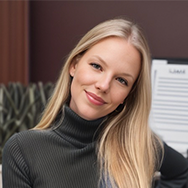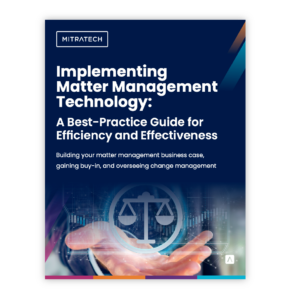Targeted, Actionable SMART Goals to Help Your Team Drive Greater Efficiency, Compliance, and Strategic Value
We’ve known for a while that legal operations teams are a strategic partner to the wider business, but thanks to research from organizations like McKinsey & Company, the legal ops function has gained more recognition as a core hub in corporate legal departments on a global scale. This shift in perspective means there are more eyes on your legal operations team’s performance and metrics than ever before.
As we approach goal-setting and review season, establishing SMART goals can be transformative for your legal ops team. These well-defined, measurable targets align your team efforts with organizational objectives, optimize resources, and foster accountability. In turn, they drive streamlined processes, cost savings, and stronger stakeholder relationships that contribute to the department’s overall success.
Not sure where to start to set benchmarks for your team? In this blog, we’ll cover 10 sample SMART goals for legal operations professionals to jumpstart your path to success:
- Increase Stakeholder Satisfaction & Improve Feedback Loops
- Optimize Legal Spend Management
- Improve Resource Allocation with Analytics
- Increase Technology Adoption and Improve Change Management Approach
- Implement a Cross-Functional Data Privacy Initiative Taskforce
- Create a Single Source of Truth Through Integration
- Standardize a Vendor Onboarding and Management Program
- Automate the Document Management Process
- Improve Self-Service Efficiency for Internal Legal Requests
- Increase Contract Compliance Through Automated Audits
First Thing’s First: What Are SMART Goals for Legal Operations Professionals?
SMART goals for legal operations professionals (or anyone, for that matter) are a framework for setting specific, measurable, achievable, relevant, and time-bound objectives. This structure helps ensure that goals are clear and actionable, making it easier to track progress and measure success. By breaking down goals into these distinct elements, legal operations professionals (and any team) can align their work more effectively with both team and organizational priorities.
The importance of SMART goals lies in their ability to transform broad objectives into concrete, attainable steps. For legal ops teams, this means providing clarity on complex initiatives, improving efficiency, and fostering accountability within the team. By defining goals that are relevant and time-bound, professionals can better prioritize tasks, reduce wasted efforts, and maximize resources — all critical for a department managing multiple stakeholders and high volumes of work. The measurable aspect of SMART goals is especially valuable for showing tangible impact, which reinforces the department’s strategic role within the company and drives continuous improvement.
Let’s look at some SMART goals that can be transferable to your legal ops team to achieve more significant, value-driven outcomes.

10 SMART Goals for Legal Operations Professionals
1. Increase Stakeholder Satisfaction & Improve Feedback Loops
Enhancing stakeholder satisfaction and collecting feedback ensures your legal ops team can continually meet client needs effectively, strengthen relationships, and adapt processes based on real input.
An example of a stakeholder satisfaction SMART goal for legal operations professionals would be: Achieve an 85%* satisfaction score in quarterly stakeholder surveys in Q1 through a refined feedback process.
Before collecting feedback and analyzing, identify who your stakeholders are. Stakeholders might include:
- Legal Team Members
- Executives and Leadership
- Outside Counsel and Vendors
- Compliance and Risk Management Teams
How can you achieve this? Implement feedback forms and respond to feedback with timely solutions. But as many managers know, asking for feedback can sometimes open the floodgates. When dealing with hundreds — or even thousands — of users, gathering impactful feedback requires a combination of quality and quantity, like vetted polls, surveys, and more finely-grained questions. How do strategic legal ops professionals go about this challenge?
The use of a workflow automation software allows you to collect and analyze feedback directly in your portal. This is because depending on someone’s stated role, how they answered a particular question, or how close your relationship is to this particular customer, you can route the feedback in several different ways. This makes sure you are receiving the right qualitative and quantitative feedback to make improvements and improve satisfaction.
2. Optimize Legal Spend Management
Improved budget control aligns legal spend with corporate goals, ensuring resources are used efficiently and minimizing unexpected costs. Reducing external legal costs supports budget management and maximizes the organization’s return on investment by encouraging efficient use of internal resources.
An example of an outside counsel spend SMART goal would be: Reduce outside counsel spend by 15%* through quarterly vendor evaluations and improved matter budgeting.
How can you achieve this? Optimizing your legal spend involves getting data on what you go to outside counsel for. For example, if you did M&A work with outside counsel, maybe you re-allocate those efforts to be internal.
Legal management software is one way to gather this data faster and more efficiently, helping you give your team real-time visibility into spend, automate compliance with billing guidelines, and prevent unplanned costs by flagging non-compliant charges. This will help to control budgets and improve financial predictability.
You can also use Artificial Intelligence (AI) and Enterprise Legal Management (ELM) to save valuable time and gather actionable analytics to track and control your spend.
This is achieved through:
- Faster payment cycles for you and your law firms
- AI-enabled analysis and categorization of legal spend
- Fully-integrated, centralized managed bill review, e-billing, matter management, and legal spend analytics
- Low-value work eliminated for attorneys and managers, especially as it relates to legal bill review
- Incremental savings on total legal spend over life of the program
- Uniformity in the processing and application of billing data
- Benchmarking data across billions of dollars and millions of time entries
- Scalability on demand
- Law firm compliance
- Detailed insights to inform critical outside counsel resourcing decisions
3. Improve Resource Allocation with Analytics
By optimizing your legal spend, you may find yourself with more time and money to focus on high-priority cases and tasks that deliver the most strategic value. By systematically tracking and analyzing where time and resources are spent, the team can reduce wasted effort on lower-impact work, thereby improving efficiency and outcomes.
Accurate reporting enables data-driven decision-making, fostering transparency and empowering leadership to make informed strategic choices.
An example of a resource allocation SMART goal would be: Outsource routine legal research tasks in Q4 to free up 20%* more time for the team to focus on case strategy and complex litigation support.
How can you achieve this? Tracking time and expenses per case type over a quarter allows legal ops to recognize which cases typically exceed budgets or experience delays, enabling them to adjust workflows and reallocate resources as needed. This structured approach not only improves immediate reporting accuracy but also builds a foundation for strategic, data-driven decisions that drive long-term performance improvements.
To achieve accuracy in reporting for litigation and matter status, legal tech tools can be your key to identifying patterns, tracking progress, and ensuring consistency. By using technology to measure and monitor metrics like case duration, cost per matter, time efficiency, and win/loss rates, teams can detect trends that help improve resource allocation and budgeting.
4. Increase Technology Adoption and Improve Change Management Approach
With 70% of digital transformations failing due to low adoption and resistance to change, boosting technology adoption and effective change management has become a top priority for legal teams aiming to enhance productivity and streamline workflows.
An example of a technology adoption SMART goal would be: Encourage and support the transition to 90%* of attorneys actively using a matter management system for all case-related documentation and updates within 6* months.
How can you achieve this? Creating change champions, implementing training, and offering ongoing support ensures that team members feel confident using new tools and understand their benefits. This structured approach to change management not only boosts technology adoption rates but also minimizes disruptions, fosters a positive user experience, and encourages consistent, long-term use of the software to achieve measurable improvements in productivity and data quality.
More things to keep in mind to increase your technology adoption include:
- Defining Strategic Goals:
- Identify short-term and long-term objectives for your new system
- Ensure goals align with overall business strategies and compliance requirements
- Assessing Current Capabilities:
- Evaluate existing processes, technologies, and resources
- Identify gaps and areas for improvement
- Prioritizing Key Initiatives
- Determine the most critical changes or implementations needed
- Rank initiatives based on impact and feasibility
- Setting Clear Milestones
- Break down your roadmap into actionable steps with specific deadlines
- Assign responsibilities for each milestone
5. Allocating Resources
- Ensure the necessary budget, staff, and technology are in place
- Plan for ongoing support and training
6. Monitoring Progress and Adapting
- Regularly review progress against the roadmap
- Be flexible and adjust the roadmap as needed based on feedback and changing needs
An effective roadmap for creating buy-in for any tool (like implementing matter management, for example), can help!
5. Implement a Cross-Functional Data Privacy Initiative Taskforce
Risk is a team sport — and legal, risk, and HR are all key players. Someone has to be driving that effort to keep everyone on the same page; why not legal? Establishing a task force not only centralizes responsibility but also keeps each department aligned on regulatory requirements like GDPR, CCPA/CPRA, and HIPAA. This coordinated approach reduces the chance of oversights, enhances cross-departmental communication, and fosters a proactive culture of compliance that strengthens the organization’s data security and safeguards its reputation.
An example of a compliance SMART goal would be: Implement a cross-functional data privacy initiative taskforce by Q2 to align compliance efforts across legal, HR, and risk, with the team meeting at least three times this quarter to outline a risk review and remediation plan.
How can you achieve this? Create an audit checklist and assign compliance reviews to designated members to ensure each department’s priorities are incorporated into the risk and compliance roadmap. Thinking about bridging the gap between different departments is an intimidating thought. But it doesn’t have to be. A connected approach to your legal and risk management means that you can access specific capabilities, configure differences, and coalesce data between core systems and departments while building a consistent risk taxonomy across different processes.
6. Create a Single Source of Truth Through Flexible Integrations
Establishing a single source of truth through application integration improves efficiency, reduces time spent on redundant data entry, and enables more accurate, data-driven insights. By consolidating data within your matter management system, your legal ops team can work more collaboratively, and the organization gains a clearer, real-time view of legal operations.
An example of an integration SMART goal would be: Connect 75%* of legal team applications with your matter management system to streamline workflows and enhance data accessibility across the organization.
How can you achieve this? Gather all data sources into a single source of truth so that all of your information on legal matters, spend management, eBilling, contract management, outside counsel selection and management, firm and panel management, and vendor invoicing are centralized and speak the same language.
By centralizing data in one system, you can reduce duplication, minimize errors, and enable your legal team to export data easily into company-wide visualization tools for better decision-making. The best part is that your existing applications do not necessarily need to be replaced or overhauled.
The right software will seamlessly integrate with your existing tech stack to ensure you don’t miss a beat when it comes to efficiency.
7. Standardize Vendor Onboarding and Management Program
A consistent vendor management approach builds a strong foundation for working with outside counsel, driving both cost-effectiveness and quality.
An example of a vendor management SMART goal would be: Complete onboarding for new firms within 60* days and achieve an 85%* adherence rate to company-defined performance and diversity metrics.
How can you achieve this? By standardizing onboarding and performance evaluations, legal ops can proactively address gaps, measure impact on key metrics (like diversity and efficiency), and maintain alignment with organizational values. This goal not only strengthens partnerships but also provides actionable insights that can refine your vendor relationships over time.
Unfortunately, with thousands of pages to review and limited time to really dive in, few teams actually learn enough from the standard RFI process to make actionable changes. This can be achieved with the help of a standardized approach that keeps the RFI and evaluation process short, strategic, and sweet — and, in the process, creates a better relationship and understanding of internal needs.
Leveraging data and peer reviews can also help you make more strategic, informed decisions on outside counsel that will best support your business and social impact goals. From pro bono contributions, to ESG efforts or commitment to innovation, there are many value sources to consider when determining the best partners for your business.
8. Automate the Document Management Process
We’re through the times where documents are passed around via snail mail to be completed — more and more workers are recognizing that freeing up this time allows them to focus on more meaningful work, leading to greater job satisfaction and productivity. In fact, a recent survey highlighted that nearly 70% of workers see the primary advantage of automation as reducing time spent on repetitive, manual tasks like data entry and document management.
An example of a document management process goal would be: Reduce time spent completing contracts by 30%* over the next 3* months.
How can you achieve this? Don’t overwhelm yourself with an endless pile of contracts. Setting up standardized templates for document generation can help significantly reduce the time you spend on crafting and creating contracts, NDAs, etc. Need a little help with creating those templates (and ensuring they’re compliant?) Implementing a standardized system for legal document management can help streamline and speed up your processes.
9. Improve Self-Service Efficiency For Internal Legal Requests
Every day, legal is bombarded with “urgent” requests that hinder efficiency and distract from larger priorities. In an effort to manage and field requests, many legal departments are looking for more efficient ways to funnel and triage them for faster time to value, streamlined drafting and review, organized document management, and self-service legal advice.
An example of a self-service goal would be: Achieve a 50%* self-service rate for standard documents like NDAs and agreements within the next year.
How can you achieve this? Replaces the frenzy of chats, emails, and one-off questions by directing anyone seeking legal advice toward the same outreach channel.
Here, they can be prompted for routine request types (contract templates) or pre-answered FAQs (like “what’s our policy for___…”). For example, suppose a requester is looking to start a contract; In that case, all the required information is gathered up front (company, address, state, parties involved, etc.) before it’s ever sent to legal, replacing the back and forth for information.
Employees can use legal request portals across the organization for things like sales contracts, vendor agreements, or just general legal questions. On the back end, legal request portals are a look into the workload of legal staff, providing valuable data on how long processes take, where bottlenecks arise, or when staffing gaps occur.
Want a closer look at how this works? Take a peek behind the scenes of a Legal Front Door Workflow.
10. Increase Contract Compliance Through Automated Audits
Limited visibility into contract status, progress, or related matters can create process roadblocks, expose organizations to inconsistencies that increase risk, and even impact revenue. World Commerce & Contracting once found that poor contract management can cost companies 9% of their bottom line. Think about what you could do with 9% more in your legal spend pocket.
Alternatively, regular audits ensure contract terms are adhered to, reducing legal risk and ensuring obligations are met, which protects the organization from potential liabilities.
An example of a contract compliance SMART goal would be: Reduce manual contract review by 25%* in 6 months*.
How can you achieve this? When automating contracts and documentation, incorporate compliance checks into your workflows. This can be done with dynamic triggers that flag records based on your predetermined criteria (high-risk contract types, values exceeding a certain threshold, contracts missing key provisions, etc.). For additional review and analysis, create a dashboard that tracks records, data submitted and metadata so your team can monitor for discrepancies or changes.
Introducing the right workflow or document automation technology can help accelerate each stage of the contract creation, review, negotiation, and approval process. This will make tremendous headway in minimizing risk and ensuring adherence to contractual obligations. Consider that 9% back in your bottom line!
Setting SMART Goals for a Stronger Legal Operations Team
Establishing SMART goals in Legal Operations is key to driving efficiency, accountability, and measurable success. Each goal — from enhancing stakeholder satisfaction to improving self-service efficiency — helps the team operate more strategically, reduce costs, and better serve organizational needs.
By focusing on specific, achievable targets, legal operations teams can align more closely with business priorities, streamline workflows, and demonstrate clear value. Ultimately, SMART goals not only sharpen team focus but also empower legal operations to become a proactive force within the organization, continuously evolving to meet new challenges.
Set your team up for a successful 2025 by implementing SMART goals this quarter.
Want help tackling them? Get in touch with our team today!
* Percentages should be determined by your internal team to align with greater business objectives.










